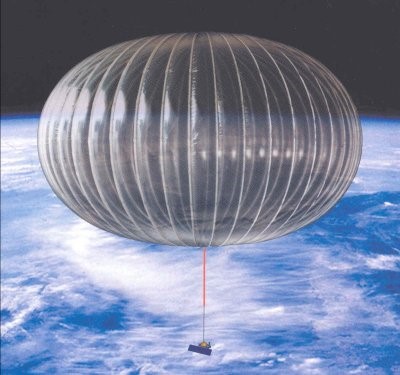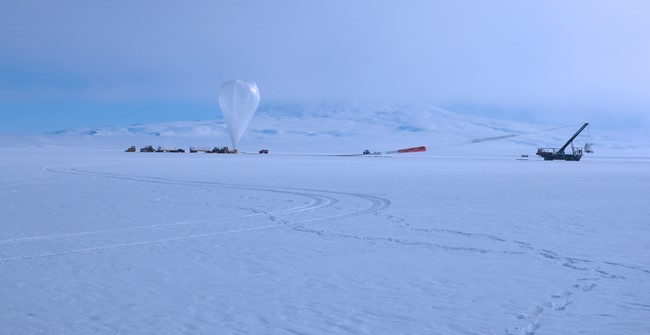Doug Bell
My career as a thermal engineer started with balloons.
Not the ones you see at birthday parties or even the big colorful ones full of hot air, but scientific research balloons: 400-foot diameter bags of helium carrying thousands of pounds of scientific experiments into the stratosphere.
Throughout my career, I have performed thermal analyses on lighter-than-air (LTA) vehicles and their payloads, from the NASA Scientific Balloon Program to several stratospheric airship programs. I’ve also done some consulting on LTA vehicle analysis.
Balloons seem so outdated compared to rocket boosters landing for reuse and airships bring to mind Zeppelins and may seem like an old-fashioned concept. Strangely enough, groups are actively improving the designs of these systems. Balloons can carry payloads of several thousand pounds above most of the atmosphere for a fraction of the price of a space launch. If the mission is short or the payload needs to return to Earth, balloons are ideal. Airships only require propulsion to overcome drag and can maintain a location for communications or observations. Think of a communications satellite that does not need to wait for a launch window and can be brought home for repairs.
You might be thinking “That is all very interesting, but how does thermal analysis fit in?”
Here are some of the thermal issues that stratospheric, LTA vehicles face.
They are (almost) satellites
Anyone who has visited the Rocky Mountains near Denver knows that the thin air at 6,000 to 12,000 feet makes it hard to catch your breath and leads to quick sunburns. On a clear night, the stars are amazing and you can feel the cold on your shoulders and head.
Stratospheric vehicles fly between 100,000 to 120,000 feet! The air is thin enough that they can be modeled like satellites: negligible convection, exo-atmospheric solar radiation, Earth infrared radiation and albedo (solar radiation reflected from the planet) below, and almost deep space above.
Unfortunately, it is not that simple. Balloons, being buoyant, do not rely on velocity to keep them at altitude. They meander with the wind with little airspeed. While the wind can move them with ground speeds of 120 miles per hours, from their perspective they are effectively standing still over the Earth. This means that their diurnal cycle is closer to 24 hours than 90 minutes like satellites in low Earth orbit. In mid-latitudes, they are in darkness for more than eight hours. I don’t think there are many satellites that do that.
At the other extreme, many balloon flights take place in Antarctica: a 24-hour view of the Sun is great for solar observatories. Not only is the system in the sun for 24 hours a day, but the icecap reflects over 50% of the incoming solar energy. Now the vehicle is seeing the equivalent of 1.5 suns. All metallic objects on the balloon and payload must be painted white or covered with highly reflective material to prevent overheating, even above the Antarctic!
Will the pressure rise or will the altitude drop?
The diurnal temperature changes not only affect the payload but the lifting gas itself. To stay at one altitude, a LTA vehicle must maintain a constant volume. If you are the slightest bit familiar with the ideal gas laws, you know that for a given volume, pressure changes with temperature. If the balloon is full and the temperature increases, the pressure increases. However, as the temperature decreases, the pressure of the gas will decrease until the volume of the gas equals the balloon volume. At that point, the volume of the balloon starts decreasing and the system drops in altitude, which usually ends up with upset scientists. The design of a stratospheric LTA becomes a balance between higher pressure and lower night-time altitude.
In the LTA world, there are two basic types of balloons: zero pressure and super pressure. Zero pressure balloons are designed to vent any gas that would cause pressurization of the envelope. Zero pressure balloons lose altitude at night as the gas cools. During the day, they ascend again, but lose gas when the gas heats up enough to fill the envelope. To limit the loss of altitude, the balloon system drops ballast. The lifting gas and ballast are obviously limited resources for the balloon. This limits the time they can stay afloat when there is a diurnal cycle.
Super pressure balloons maintain a constant volume by pressurizing during the day. Due to the pressure requirements, the material must be strong. The material for a super pressure balloon is almost twice the thickness of the material used for zero pressure balloons leading to a heavier system. A heavier system leaves less allowance for payload or a lower float altitude. Super pressure balloons are not new, but newer designs are allowing larger payloads to reach higher altitudes.
Zero pressure balloons have been the heavy-lifting workhorse of the NASA balloon program and are sufficient for short-duration flights. For longer flights, the new designs are just now being proven and will likely replace zero pressure balloons.
We are off to the ballonet
Airships have yet another challenge: unlike balloons, airships typically have propulsion so they can be directed from one location to another regardless of wind direction. One typical use for stratospheric airships is communication requiring them to stay in one location or station-keep. This requires a specific shape with low drag. Stratospheric airships maintain their shape throughout the flight using a ballonet (bal-o-nay).

Think of a ballonet as a balloon within a balloon. Historically, ballonets have been used for low-altitude airships to change the mass of the airship in order to adjust their altitude or pitch (more air in the aft ballonet aims the nose up). For stratospheric airships, the ballonet is primarily used to keep the shape of the airship throughout the flight. Because the lifting gas expands almost ten times its volume at launch, the ballonet for a stratospheric airship must span 90% of the airship volume.
During ascent and descent, the air in the ballonet must be controlled to limit the pressure but to maintain the shape, especially against dynamic pressure of flight and ascent. Between launch and float, convection can play a bigger role, especially moving through the tropopause with air temperatures around -55°C. This must be combined with solar and IR loads and the change in atmospheric pressure to evaluate the ballonet control system.
Where are we now?
 Just last month, a new design of super pressure balloon was circumnavigating the globe. The balloon was launched from New Zealand and flew for more than 46 days. You can see its flight path here: http://www.csbf.nasa.gov/newzealand/wanaka.htm. Smaller super pressure balloons have flown for more than a year, but they were much smaller and did not carry near as much payload as the new design. For balloons the same size as the current one, the record is around 54 days set by a test of the same balloon design in Antarctica. The big difference is that the current flight is going through diurnal cycles (sunrises and sunsets).
Just last month, a new design of super pressure balloon was circumnavigating the globe. The balloon was launched from New Zealand and flew for more than 46 days. You can see its flight path here: http://www.csbf.nasa.gov/newzealand/wanaka.htm. Smaller super pressure balloons have flown for more than a year, but they were much smaller and did not carry near as much payload as the new design. For balloons the same size as the current one, the record is around 54 days set by a test of the same balloon design in Antarctica. The big difference is that the current flight is going through diurnal cycles (sunrises and sunsets).
Stratospheric airships are still in our future. While several groups have attempted designs, fewer have actually had demonstrator flights (I can only find information about one in the past 15 years). As mentioned earlier, the benefits could be great: satellite-type systems for communication or observation with the ability to repair and maintain the equipment. Eventually, I expect stratospheric airships may become as common as Zeppelins were in the last century.
With all that is going on with LTA, perhaps I can say my career has a bright future because it is “up in the air.”

